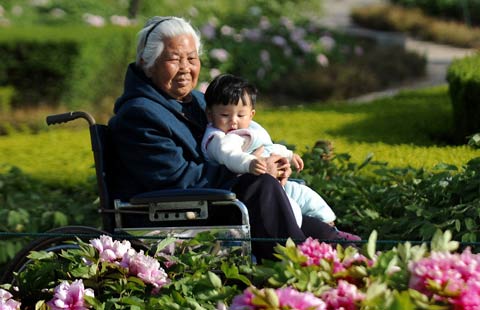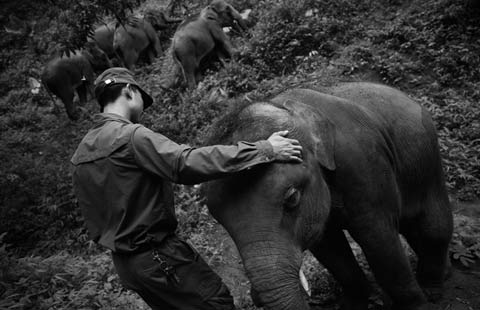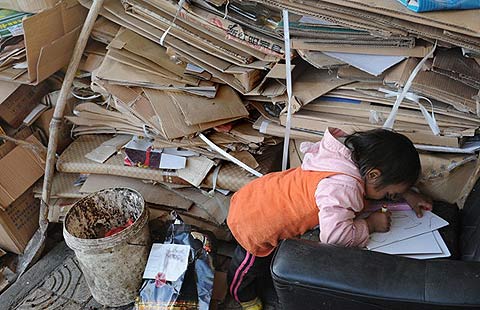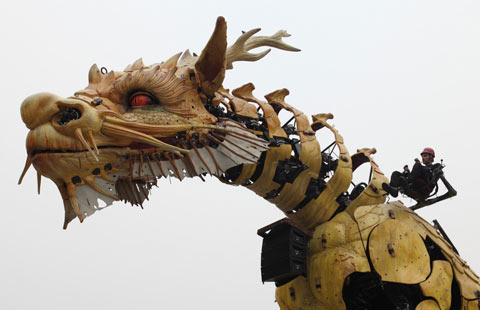The art of seeing in world of darkness
Updated: 2014-10-31 14:11
By Mao Xi For China Daily(China Daily Europe)
|
|||||||||||
French artists Monique Plumecoq and Andre Soler say their dreams came true when Chinese painter Zhou Chunya chose their works for his foundation's exhibit in Chengdu.
For the "Possibility: International Disabled Artists Exhibition" in Chengdu, Zhou said he applied the same standards of evaluating art to Plumecoq and Soler's works.
Plumecoq, who is blind, has been a sculptor for 20 years and a painter for five years. As a visually impaired child, her dream was to paint, but French art schools in the 1960s did not accept people with visual disabilities. Instead, she worked for 15 years as an accountant. Her impairment worsened until she could no longer work. To remain active, she trained as a psychotherapist and later attended Sylvie Sanchez's sculpting classes at Creative Handicap, a collective in France for the disabled, to discover and make art.
Artistically, Plumecoq synthesizes everything that she has touched or heard to find her own style of sculpting, which balances figuration and abstraction. But while sculpting has taught her the basics of composition and the mastery of materials such as clay, plaster and paper, painting was a different story.
Five years ago she began painting and experimented with many techniques. At the time, she could still see colors and shapes. When she did not like the way the brush felt, she painted with her fingers to avoid having any barriers with the colors she used. After having tested several media, she tried painting on Braille paper and says the texts she reads with her fingers inspire her works.
Andre Soler, a blind photographer, says he does portraits to become better acquainted with people and to bring out their personality. Soler's other passion is photojournalism, something he has done for 10 years.
Soler says he surrounds himself with photographer friends who share their knowledge about the trade. He also keeps himself up-to-date with the latest technological developments in photography that might help improve his work.
He takes pictures with the help of a device that sends signals on how to adjust the contrast, focus and lighting. He uses voice-recognition software to transfer photos to his computer and to navigate certain programs to finalize his pictures.
The photos displayed in Chengdu were taken during solo trips to different countries since 2003. In 2008, a few months after seeing a TV report about the Terracotta Warriors in Xi'an, he traveled to China to visit the sculptures, staying in the country for 20 days to also visit Shanghai, Hong Kong, the Great Wall and the Mausoleum of Emperor Qin Shihuang.
For him, the subject of every photograph is a way to tell something about life and to show that his visual disability has become an asset. His will and desire to learn are helping him overcome the obstacles of his disability.
Plumecoq is heavily involved in activities to help the disabled in France. She helps facilitate access for the disabled to museums and art galleries, such as Museu Picasso in Barcelona and Musee d'Orsay and the Centre Georges Pompidou in Paris.
Soler is an avid sports fan and has run races in Paris and participated in sports competitions for athletes with disabilities.
|
Monique Plumecoq was delighted to touch the Green Dog, an object from the famous painting series by Zhou Chunya. Provided to China Daily |
(China Daily European Weekly 10/31/2014 page26)
Today's Top News
Trilateral talks on Ukraine gas reaches agreement: EU
Culture ministry: no politics, no propaganda, only China
World Bank pledges $100m more to fight Ebola outbreak
Canadian PM to attend APEC
Russia 'willing' to co-op with Ukrainian parliament
China to help build Ebola quarantine center in Liberia
Tycoons' gift to Yale stirs debate
180 'foxes' hunted back to China
Hot Topics
Lunar probe , China growth forecasts, Emission rules get tougher, China seen through 'colored lens', International board,
Editor's Picks

|

|

|

|

|

|






